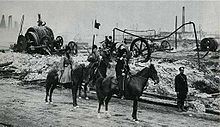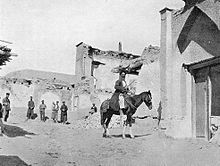| Revision as of 10:17, 28 October 2007 editFolantin (talk | contribs)Autopatrolled, Extended confirmed users, Pending changes reviewers, Rollbackers27,187 editsm moved Armenian-Tatar massacres to Armenian-Azeri massacres 1905-1907: "Tatar" is old-fashioned and confusing to English readers← Previous edit | Revision as of 10:19, 28 October 2007 edit undoFolantin (talk | contribs)Autopatrolled, Extended confirmed users, Pending changes reviewers, Rollbackers27,187 edits Rmv Stalin as a source. For God's sake!Next edit → | ||
| Line 3: | Line 3: | ||
| ] | ] | ||
| ] | ] | ||
| The '''Armenian- |
The '''Armenian-Azeri massacres''' also known as the '''Armenian-Tatar War''' of ]—] refers to the bloody inter-ethnic confrontation between the ]s (which were then referred to as Azerbaijani or Caucasian ] in Russia) and ] throughout the ], then part of ]. The events were caused by hostility between ] Azeris on one side and ] Armenians on the other. They were allegedly incited by the Russian government in order to reinforce its own authority during the revolutionary turmoil of 1905. | ||
| The massacres started during the ], and claimed hundreds of lives. The most violent clashes occurred in ] in February in ], in May in ], in August in ] and in November in ], heavily damaging the cities and the ]. Some violence, although of lesser scale, broke out also in ], but the local ], the only force enjoying popular confidence, was able to intervene between the two communities and to prevent larger carnage in the city. | The massacres started during the ], and claimed hundreds of lives. The most violent clashes occurred in ] in February in ], in May in ], in August in ] and in November in ], heavily damaging the cities and the ]. Some violence, although of lesser scale, broke out also in ], but the local ], the only force enjoying popular confidence, was able to intervene between the two communities and to prevent larger carnage in the city. | ||
| ==Bibliography== | ==Bibliography== | ||
| *''Stalin: A Critical Survey of Bolshevism'' at . | |||
| *Thomas De Waal (2004), ''Black Garden: Armenia and Azerbaijan Through Peace and War'', NYU Press, ISBN 978-0-8147-1945-9 | *Thomas De Waal (2004), ''Black Garden: Armenia and Azerbaijan Through Peace and War'', NYU Press, ISBN 978-0-8147-1945-9 | ||
| ] | ] | ||
Revision as of 10:19, 28 October 2007



The Armenian-Azeri massacres also known as the Armenian-Tatar War of 1905—1907 refers to the bloody inter-ethnic confrontation between the Azeris (which were then referred to as Azerbaijani or Caucasian Tatars in Russia) and Armenians throughout the Caucasus, then part of Imperial Russia. The events were caused by hostility between Muslim Azeris on one side and Christian Armenians on the other. They were allegedly incited by the Russian government in order to reinforce its own authority during the revolutionary turmoil of 1905.
The massacres started during the Russian Revolution of 1905, and claimed hundreds of lives. The most violent clashes occurred in 1905 in February in Baku, in May in Nakhchivan, in August in Shusha and in November in Ganja, heavily damaging the cities and the Baku oilfields. Some violence, although of lesser scale, broke out also in Tbilisi, but the local Social-Democratic Party, the only force enjoying popular confidence, was able to intervene between the two communities and to prevent larger carnage in the city.
Bibliography
- Thomas De Waal (2004), Black Garden: Armenia and Azerbaijan Through Peace and War, NYU Press, ISBN 978-0-8147-1945-9
This Asian history–related article is a stub. You can help Misplaced Pages by expanding it. |